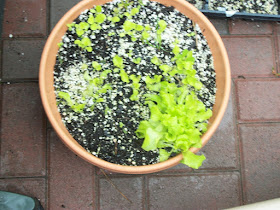Every Friday night, my sister and I work on getting our parents house ready to sell. My mom died on May 25 and my dad didn't make it much longer and he died on November 10th last year. I just read that June Carter Cash died in May and Johnny died the following September, too. The elder law attorney warned me this would likely happen. Once one goes, the other goes soon after. My parents were married for 48 years, and I don't think they ever got rid of anything in their time together; they both were hoarders. So on Fridays, I leave my office and head back to Warren to meet up with my sister to sift through almost 50 years of their stuff. We'd hoped to get the house on the market by June but that's clearly not going to happen as we have just gotten through the upstairs of their 900 sq. ft. house and are now commencing on the basement, which can't be walked through, it's got so much stuff.
It's only fitting that we'd have a huge storm on the 1st anniversary of my mom's death. My parents house, which was built in a subdivision that sprang up like many did when GM opened the Tech Center in 1956. I learned as a kid that our subdivision was once part of the Rinke Farm, and our elementary school was named Rinke Elementary. My mom was a wonderful gardener and the soil was great, however we lived at the end of a gradual decline so when it rained, the water always ran down to our yard and basement. We spent many hours bailing water out of our basement whenever there was a big rain. We expected the basement to flood and then that would simplify our housecleaning process - we could just throw everything out. Oddly, the basement stayed dry. My sister (who lives a few blocks north in a house on another part of Farmer Rinke's land) had a half foot of water in her basement. Driving down any Warren street sees a van from flood remediation companies in most everyone's driveway. But not my parents house - dry as a bone. Weird.
 |
| View from the dam at the lower lake |
 |
| Workers trying to divert rain water from the pool at the country club |
We drove around and took pictures of it all so we could remember. Bridgeway was completely washed out as Boyden Creek attempted to become a creek again.
 |
| Bridgeway as viewed from Crestline |
 |
| The base of Cardiac Hill (famous sledding in winter!) |
Boyden Creek had almost reached the top of the Huron River Bridge. I've never seen it this high.
 |
| Boyden Creek runoff |
Here's the view from the path near a place we call "Lane 10". I think it was supposed to be a road someday, but now it gets storm runoff.
 |
| Eagle Bridge |
It was the kind of storm my mom would have called to warn me about. My parents, who watched the news 24/7 like most old people do, were always the first to call about a tornado watch or flood warning. The weather has been really disappointing this spring...most of moms flowers are not yet in bloom. I remember last May 25, I picked her a bouquet of rhododendron, roses and flowers from the snowball bush that was at her bedside when it was her time to go. None of those flowers are in bloom at the old house yet. There were still blooms on dad's lilac bush, which is really late for lilac. I've been taking some of her plants home each Friday. I've got her purple clematis on my mailbox - last year, it was in bloom and so striking that the hospice nurse had to ask me what it was. This year, there's buds but no flowers yet. It's been a cold, wet May this year. Here's to a better June!













